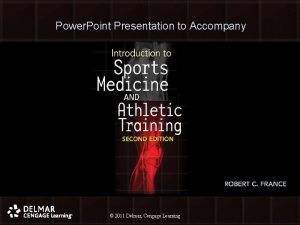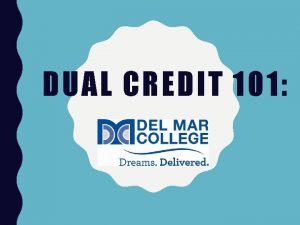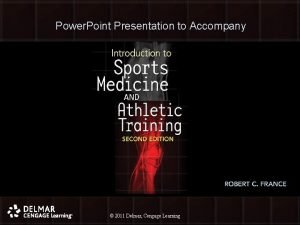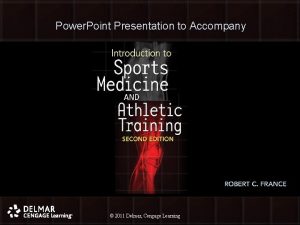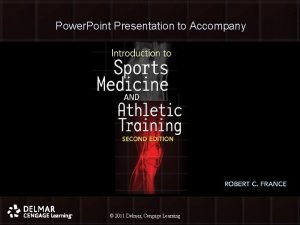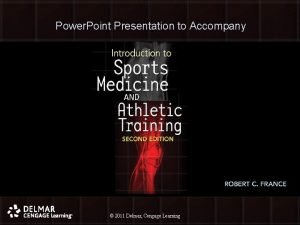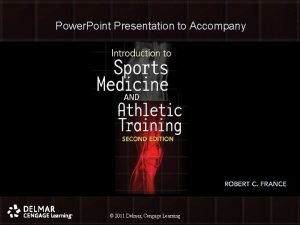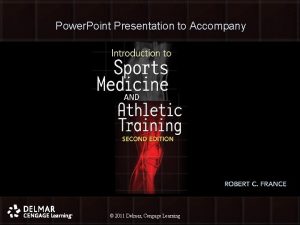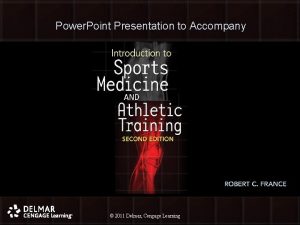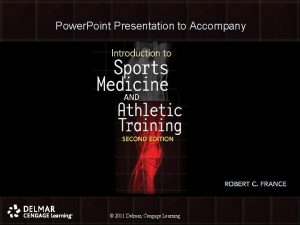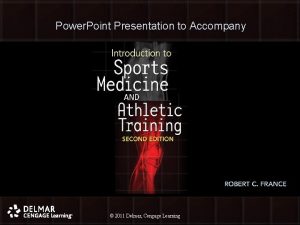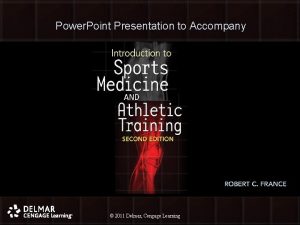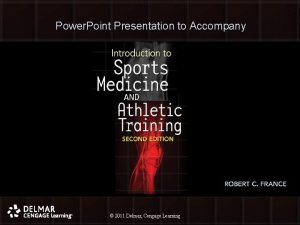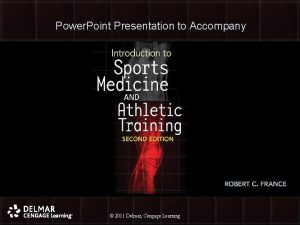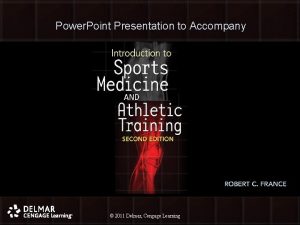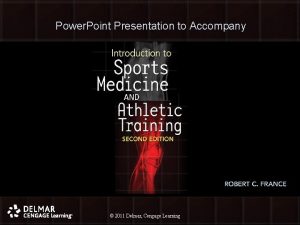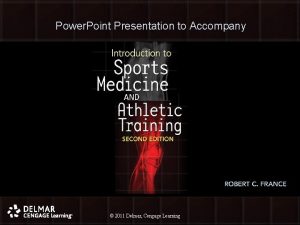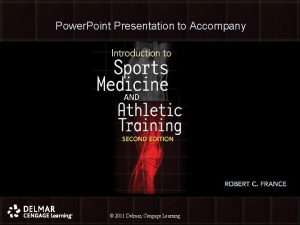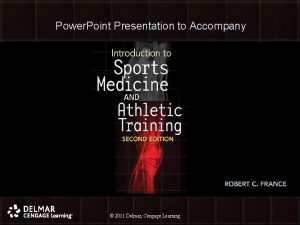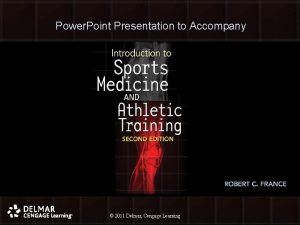Power Point Presentation to Accompany 2011 Delmar Cengage




















- Slides: 20

Power. Point Presentation to Accompany © 2011 Delmar, Cengage Learning © 2010 Delmar, Cengage Learning

Chapter 10 Sports Psychology © 2011 Delmar, Cengage Learning © 2010 Delmar, Cengage Learning 2

Objectives • Upon completion of this chapter, you should be able to: – Discuss the importance of sports psychology to athletic performance – Describe goal setting and its effect on motivation – Draw up a personal goal-setting program – Explain the difference between imagery and simulation © 2011 Delmar, Cengage Learning © 2010 Delmar, Cengage Learning 33

Objectives (cont’d. ) • Upon completion of this chapter, you should be able to (cont’d. ): – Explain the benefits and dangers of stress – Discuss the dangers of burnout – Describe career opportunities in the field of sports psychology © 2011 Delmar, Cengage Learning © 2010 Delmar, Cengage Learning 44

Sports Psychology • Study of sport and exercise, and mental factors influencing performance • Mind, body, and athletic performance connection is powerful – Often said that performance in a sport is 95% mental © 2011 Delmar, Cengage Learning © 2010 Delmar, Cengage Learning 55

Sports Psychology (cont’d. ) • Sport psychologists can help athletes develop: – Goals – Self-confidence – Motivation – Positive self-image – Strategies to cope with stress and disappointment © 2011 Delmar, Cengage Learning © 2010 Delmar, Cengage Learning 66

Motivation • Internal state or condition that activates or energizes behavior and give it direction – Extrinsic • Driven by some type of external reward – Intrinsic • Require no external support or reinforcement © 2011 Delmar, Cengage Learning © 2010 Delmar, Cengage Learning 77

Goal Setting • With goals in mind, the individual can: – Achieve more – Improve performance – Improve the quality of training – Increase motivation to achieve at a higher level – Increase pride and satisfaction in performance – Improve self-confidence © 2011 Delmar, Cengage Learning © 2010 Delmar, Cengage Learning 88

Goal Setting (cont’d. ) • Research has shown that people who use goal setting effectively: – Suffer less from stress and anxiety – Concentrate better – Show more self-confidence – Perform better – Are happier with their performances © 2011 Delmar, Cengage Learning © 2010 Delmar, Cengage Learning 99

Goal Setting (cont’d. ) • Guidelines: – Express goals positively – Set priorities – Document goals – Use operational goals – Set performance goals, not outcome goals – Set specific goals – Set goals at the right level – Set short-term and long-term goals © 2011 Delmar, Cengage Learning © 2010 Delmar, Cengage Learning 1010

Imagery and Simulation • Imagery: – Training process done purely within the mind – Helps create, modify, or strengthen neurological pathways important to muscle coordination – Imagination is the driving force – Allows athletes to practice and prepare for events – Can help “slow down” complex skills © 2011 Delmar, Cengage Learning © 2010 Delmar, Cengage Learning 1111

Imagery and Simulation (cont’d. ) • Simulation: – Seeks to improve quality of training by teaching the brain to cope with circumstances that will not be encountered until competition – Carried out by making physical training circumstances as close as possible to real competition © 2011 Delmar, Cengage Learning © 2010 Delmar, Cengage Learning 1212

Strategies to Cope with Stress and Disappointment • Stress can be healthy – Helps to increase awareness, maintain a clearer focus, increase motivation, and filter out distractions • Too much stress can hinder performance © 2011 Delmar, Cengage Learning © 2010 Delmar, Cengage Learning 1313

Strategies to Cope with Stress and Disappointment (cont’d. ) • Transitional stress typically occurs when: – Beginning a new sport – Going from high school to college – Changing leagues – Changing levels of competition – Going from junior high to high school – Going from college to professional – Retiring from athletics © 2011 Delmar, Cengage Learning © 2010 Delmar, Cengage Learning 1414

Strategies to Cope with Stress and Disappointment (cont’d. ) • Injury – Can be devastating to the motivated athlete • Burnout – Physically and mentally challenging – Manifests as dropping out of a sport and quitting an activity that was once enjoyable © 2011 Delmar, Cengage Learning © 2010 Delmar, Cengage Learning 1515

Strategies to Cope with Stress and Disappointment (cont’d. ) • Ways to manage stress: – Goal setting – Meditation – Positive thinking – Time management – Talking with friends – Taking breaks © 2011 Delmar, Cengage Learning © 2010 Delmar, Cengage Learning 1616

Self-Confidence • Reflects athlete’s assessment of his or her own self-worth • Allows athletes to take risks because they have belief in their own abilities • Consistent failure can lead to a lack of self -esteem © 2011 Delmar, Cengage Learning © 2010 Delmar, Cengage Learning 1717

Self-Confidence (cont’d. ) • Confidence should be based on observed reality – Overconfidence and underconfidence are both damaging © 2011 Delmar, Cengage Learning © 2010 Delmar, Cengage Learning 1818

Careers in Sports Psychology • Educational sports psychology – Emphasizes working with athletes in an educational environment • Clinical sports psychology – Treats athletes in a clinical setting • Academic sports psychology – Focuses on research and teaching © 2011 Delmar, Cengage Learning © 2010 Delmar, Cengage Learning 1919

Conclusion • Sports psychology is the study of the mental factors influencing performance in sport and exercise • Goal setting can help the athlete attain greater success by focusing his or her energy in a positive, measurable way © 2011 Delmar, Cengage Learning © 2010 Delmar, Cengage Learning 2020
 2009 delmar cengage learning
2009 delmar cengage learning 2009 delmar cengage learning
2009 delmar cengage learning Introduction to medical terminology chapter 1 answer key
Introduction to medical terminology chapter 1 answer key Measuring and recording apical pulse
Measuring and recording apical pulse Chapter 6 skeletal system
Chapter 6 skeletal system Chapter 13 medical math
Chapter 13 medical math Chapter 10 cultural diversity
Chapter 10 cultural diversity Delmar cengage learning instructor resources
Delmar cengage learning instructor resources Hebrews 6 9
Hebrews 6 9 Accompany chapter 1
Accompany chapter 1 Axillary lymph nodes
Axillary lymph nodes Printers create objects such as prototypes and models.
Printers create objects such as prototypes and models. Presentation in hindi topic
Presentation in hindi topic Power point presentation design west vancouver
Power point presentation design west vancouver Delmar isotonic
Delmar isotonic Delmar tsi
Delmar tsi Delmar international (thailand)
Delmar international (thailand) Thomson delmar learning
Thomson delmar learning Borgify
Borgify Draw power triangle
Draw power triangle Informsu
Informsu














